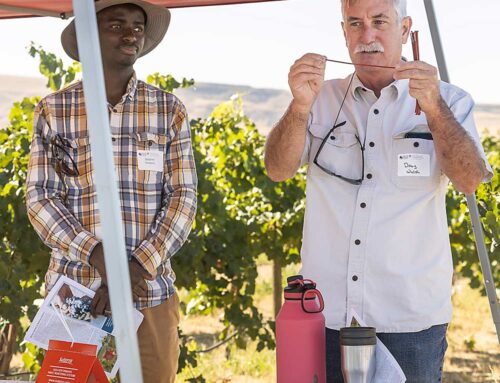
Inspire Development Center’s Grandview, Washington enrollment of 72 children are entirely from farm worker families living in the lower Yakima Valley. (TJ Mullinax/Good Fruit Grower)
Child care, a universal topic among working parents, is not generally a focus of agriculture. Yet a Washington State agricultural employers group believes solving farmworker child care needs will create labor opportunities in a shrinking pool of workers.
The Washington Growers League, an organization typically focused on labor management, worker safety, and other legislative and regulatory changes that affect agricultural employers, is exploring ways to help growers cooperatively provide child care as a means of expanding the existing domestic farm work force.
Maximizing and better utilizing domestic farm labor is one of the drivers behind getting involved in the child care issue, says Mike Gempler, executive director of the agricultural employer group based in Yakima.
His organization is also interested in supervised child care as it relates to child safety on farms and helping employers avoid child labor law violations.
The Growers League’s involvement in child care stems from a farm safety project initiated last year when the group received a $10,000 grant from the Agricultural Safety and Health Council of America. The project “Safe Play Zones for Farmworker Children” deals with child safety on farms and developing child-safe play areas in the field.
Revelation
As the Growers League began interviewing workers and employers for the safe play zone project, an issue repeatedly mentioned was child care.
“We discovered there are a lot of women who would like more farm work hours—and some who aren’t doing farm work but would like to—but they are limited by child care,” he said. “This was somewhat of a revelation to us.”
He noted that women are employed in orchards, vineyards, and packing houses, and generally do very good work in labor-intensive crops.
The child care revelation has led to a joint project between the Growers League and a Yakima Valley orchardist who is interested in using child care vouchers as a way to recruit more employees, as well as keep the female employees he has.
“The employer’s crews are running 70 to 80 percent female and he wanted to expand their hours,” Gempler said.
The female employees work less on a weekly basis than their male counterparts but they’ve told the employer they would work more hours if they had better day care options.
Gempler said as they interviewed women living in farm labor housing, many shared that they didn’t work afternoons because they needed to be at the house when the school bus dropped off children.
“Here we are in a labor shortage, and we have people living on a grower’s property who want to work, but can’t because of the lack of child care,” he said.
Black mark
Although there is substantial subsidization of child care from state and federal programs, such as Inspire Development Centers and Migrant and Seasonal Head Start, Gempler says failures still occur and children are brought to the fields.
Though children in the fields are a rarity, allegations by labor advocacy groups of child labor law abuse in agriculture have been a long-standing frustration of his. Three Washington berry employers were fined by the U.S. Department of Labor in 2011 for hiring underage children, and shipments of fruit were prohibited under the “hot goods” provision of the federal Fair Labor Standards Act.
He says the majority of his employer-members have policies against bringing underage minors to work, but it still happens. “Employers don’t want it, they don’t plan on it, but kids sometimes come with parents because there’s a breakdown in day care. We want kids to be safe and we don’t want farmers in trouble, getting a smear of largely undeserved publicity from child labor on farms.”
Assessing needs
Part of the grant is being used to survey agricultural employers and employees to assess what kind of help the grower needs in offering child care and the extent of child care need and demand from employees.
“A number of programs, like Migrant Head Start, cater to the needs of field workers by having early hours and are located in rural areas,” Gempler said. “But do we have enough and are they in the right locations? Do farmworker families know about the resources available? We’re trying to determine why failures occur.”
As part of the needs assessment, they’ve already found that some rural areas no longer have farmworker child care programs due to funding cuts.
“There’s widespread demand for child care in rural areas,” he said. “It’s not just farm workers who need child care. It’s also office workers in packing houses and owners and operators of farms.”
Gempler learned from interviews that the vast majority of child care is provided by “FFN” (family, friends, and neighbors). In many cases, such child care is not licensed, and providers don’t have the resources for an educational component. “Unfortunately, child care given by FFN often results in children parked in front of the television.”
Education is highly valued by farm worker parents, according to Growers League data. “When given the option, they would prefer that their children have early education and learn to speak English before entering school,” he said. “Early education is something that will benefit our communities and is an aspect that’s important to the Yakima Valley orchardist that we are working with.” (The orchardist was not identified.)
After the Growers League identifies where child care needs are, opportunities that exist, and a cost analysis of different options, the ultimate goal is to augment existing services and help create more child care facilities. For example, growers could cooperatively work together with churches in rural areas to create new programs.
“We want to bring employers, employees, and communities together,” he said. “There’s a lot of common need and concern, and we want to help them recognize opportunities. It’s all part of investing in and maximizing our domestic work force.”
Gempler says it’s also one of the responsibilities of growers who have turned to the federal H-2A guestworker program to fill their farm employment needs. A key requirement of the H-2A program is that growers must first prove through recruitment efforts that domestic workers are not willing and available.
“The H-2A program is a real necessity for agriculture, and it will continue to be used, but domestic workers are not only the majority of our work force, they are a key source of potential new workers,” said Gempler. “We need to do a better job of recruiting domestic workers and enable them to work in agriculture.” •






Excellent article. Thanks for publishing this important story.